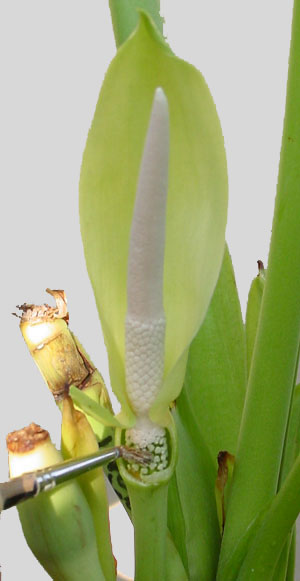

Pollinating Alocasia
This is the first step in producing a hybrid plant. Our technique involves cutting a portion of the spathe away near the base of the inflorescence so as to gain access to the pistils.
Once the pistils are exposed, we then gently dab the dry brush onto the moist pistils before dipping it in the pollen we intend to use for our cross. Then we dab the pollen-laden brush onto the pistils, placing pollen on as many of them as is possible.
We do not cut the entire spathe away as we feel that it offers some protection to the developing berries.
The technique illustrated here is for Alocasia pollination; Philodendron pollination is somewhat different because the pollen is moist, not dry, and the timing is much different.
The upper picture illustrates an inflorescence of the Alocasia "Borneo Giant", and the lower picture shows what the inflorescence of Alocasia alba (crassifolia) looks like.
When is the right time to pollinate, and when can pollen be collected? First, the pistils on Alocasia are receptive when the inflorescence first opens, while the pollen is shed a day or so afterwards. The exact timing is dependent upon the ambient temperature; when the weather is cool, the pollen many not shed for two or three days, while when the weather is warm, the pollen is shed on the day after the pistils are receptive. Experience and familiarity are keys in performing a cross that has a good likelihood of success.
Also, it pays to repeat crosses that did not succeed the first time, because oftentimes the difference between success and failure is a matter of hours or minutes. This is especially true when the weather is variable, as the winters in south Florida often are.
| In the Lab | Home | The Species | Fruiting | The Hybrids |